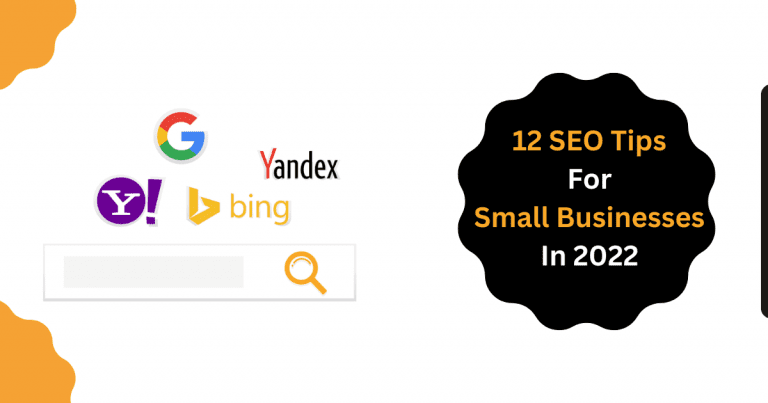SEO stands for ‘ search engine optimization ‘, Which is a set of rules that are used to make your website rank higher on search engines like google, Bing …
The more you optimize your web pages for SEO, the more visibility and traffic you can drive to your website. Therefore, the more sales you can generate.
So, when someone looks for a product or service related to your business on google and you appeared on the first page, it’s more likely for that person to visit your website and buy from you, Right?
That’s why every small business owner whose seeking more profits and sales should use SEO to drive free traffic and sales to His / Her website.
In this SEO guide for beginners, we’ll walk you through everything you need to know about SEO and How It Works?
1- SEO Basics:
Before digging more Into SEO, We need to learn some basic SEO terms to better understand the next chapters, Okay?
1-1- On-Page SEO Vs Off-Page SEO :
On-Page SEO is any activity you perform on your website that aims to help search engines to better understand and digest your content.
Examples:
A- Focus Keyword
B- Titles
C- Meta description
D- URLs Or Permalinks…
Off-Page SEO refers to any activity you perform outside of your website to help improve your SERP position ( ‘ SERP ‘ stands for ‘ search engine results pages ‘ ).
Examples :
A- Link Building
B- Brand Mentions
C- Guest Posting
D- Local SEO…
Pro Tip: Building a successful SEO strategy involves both off-page and on-page SEO techniques.
1-2- White Hat Seo Vs Black Hat Seo:
In SEO, these two terms are used to describe two different groups of SEOs, those who stick firmly to the rules set out by Google’s Webmaster guidelines and those who don’t.
Black hat SEO refers to a set of illegal practices that are used to improve the rankings of websites.
Black hat SEO tactics include :
- Buying Links for SEO
- Duplicating content
- Spamming
- Keyword Stuffing ( Keyword stuffing is when you stuff your focus and side keywords in the Title, meta description, and permalink so that it appears more than once on the page to manipulate and trick search engines ) …
These tactics can get your website to the top SERPs ( Search engine result pages ) in a short period. But, search engines will mostly ban/penalize the website sooner or later.
White hat SEO ( Sometimes called ethical SEO ) means attempting to move up the ranking while staying within Google’s privacy terms.
White hat SEO tactics include :
- Using relevant keywords.
- Providing useful content
- Proper titles and meta descriptions
- Easy navigation …
White hat SEO may take some to get your website to appear in the first page results. But, In return, your website gets long-lasting rankings ( Which means more organic traffic ).
2- How Search Engines Work:
2.1- What is A Search Engine?
A Search Engine is an online software that helps people to search for information on the world wide web ( Google As An Example ).
2.2- How Do Search Engines Work?
Search engines work through three main steps, which are:
- Crawling
- Indexing
- Ranking
And lastly, showing the results to the user in a classified way.
Crawling: is the process by which search engines browse the web and store the data collected in its index through programs called ‘ spiders ‘ or ‘ Crawlers ‘.
Example: Let’s assume that you have a website ‘ www.abcd.com ‘, the crawler will open your website and scan all the data available on it and save it in its index.
Indexing: once search engines finish crawling, they start to analyze and categorize all the data received and finally store it in their index to be used as a search result.
Ranking: When an internet user submits a query, search engines dig into their index and pull out the best results possible.
2.3- Based on what search engines choose results?
Search engines choose results based on a lot of factors like :
- High-Quality Content: Search engines like to keep their users happy and satisfied. So, If your website provides helpful and useful content for visitors. You may get some authority and trustworthiness in the eyes of Search engines, which will eventually result in higher rankings.
- Unique Content: Do Not Duplicate content from other websites and write your content on your own to avoid plagiarism.
- Ctr ( Click-through rate ): Try to optimize your titles and meta descriptions to increase the CTR of your pages.
- Website Speed: Search engines want your website to load quickly and provide a pleasant user experience for your visitors. If your website takes too long to load, it will push your visitors to leave before visiting any page.
Note: There are a lot of tools that can help you increase your website’s speed. But the best one yet is WProcket.
- Mobile responsiveness: it refers to whether a website is optimized for mobile screens or not. You should make sure your website works well on all devices. Especially, That most internet users come through mobile devices.
- Crawlable website: If you want to rank higher on search engines, your website should be easy to find by search engine crawlers.
- Backlinks: Having a lot of backlinks to your website can increase your traffic dramatically. Especially, if you get those links from high-authority websites.
- Eat ( It Stands For Expertise, Authority, Trust ): You should build a strong brand around your website to prove that you’re an expert in your field to gain more authority and trustworthiness from search engines.
3- Keyword Research :
Keyword Research is the first and most important step that should come to your mind while beginning with your optimization mission.
What Is Keyword Research ?
It is simply, the process of finding and analyzing actual search terms that people enter into search engines to look for information.
Your goal in keyword research is to understand what words and phrases your audience are using in their searches to improve and optimize your webpages for those exact keywords.
Why To Do Keyword Research ?
Because it helps to gain more organic traffic from search engines without paying anything for ads.
When To Do Keyword Research ?
Basically, keyword research is the very first step of search engine optimization of any website.
In general, we do keyword research when :
1- We search for new content ideas
2- We search for new niches
3- We optimize our own content
Who should do keyword research?
Any website owner, digital marketer, seo specialist, blogger…
How To Find Keywords ?
The best way to do keyword research is by using a keyword research tool because doing it manually is not always accurate and efficient.
There are many tools and platforms where you can do keyword research, some of them are free ( Such as Jaaxy, Answerthepublic, Soovle … ) and some others are paid ( Such as KWfinder, SEMrush, Ahrefs, Ubersuggest … )
Now, you may wonder if you should pay for a keyword research tool or not, Right?
Well, The answer is YES and here’s why :
1- Because paid tools offer more features and metrics that can help you get a lot of keyword ideas in a very short period.
2- Professional keyword research tools provide data that is almost impossible to find elsewhere.
3- You get a competitive advantage over your competitors who do not use any keyword research tool.
In general, doing keyword research consists of three main steps, which are:
1- Finding
2- Analyzing
3- Using the keywords.
And with a keyword research tool on your side, you’ll cover both the first and second steps at one time.
There are two methods to approach the research in a keyword tool:
1- Search based on a focus keyword
2- Competitor keyword research
1- 1. Search based on a focus keyword:
as you can guess from the title, this method starts with a focus keyword; which can be any word or phrase that describes the topic.
NOTE: I’m using KWfinder as a keyword research tool in this guide because it supports both focus keyword and competitor keyword research.
Now, Let’s assume that you want to rank for the keyword ” smartphones “, you simply enter the keyword into the tool and click on ‘ Find keywords ‘.
And the tool will display to you all related keywords and questions to your main one with all the SEO metrics you need ( Like search volume, keyword difficulty, Cpc … )
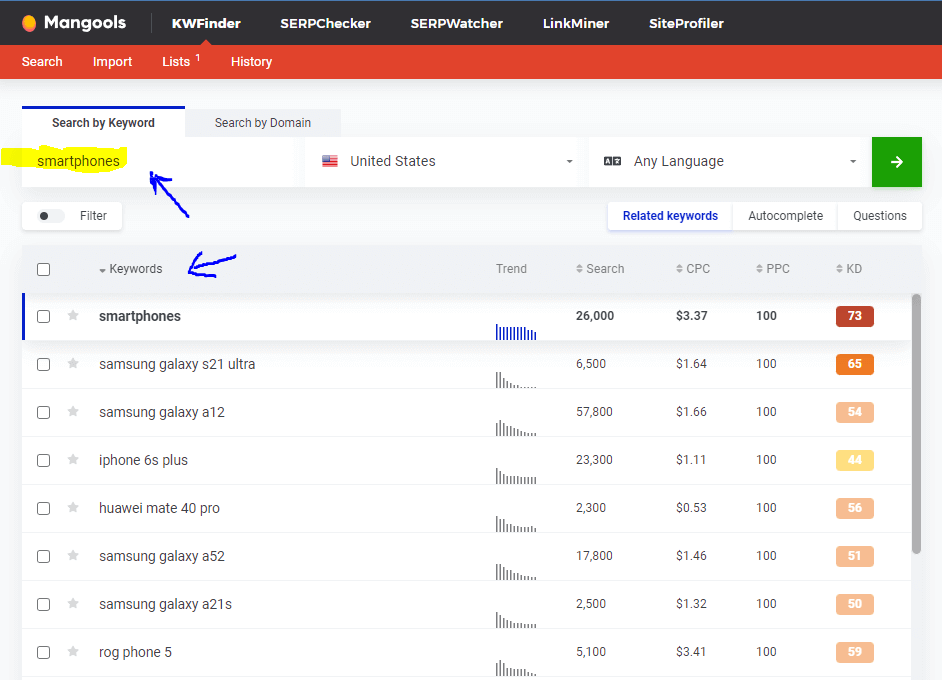
1-2- Competitor keyword research:
There are mainly two ways to competitor keyword research :
A- Copy your competitor’s domain to get new topic ideas:
By understanding which keywords your competitors are ranking for, you can find new topic ideas that you can cover with your website.
Let’s take an example of a popular website in the ” Smartphones niche ” to see what keywords they’re ranking for.
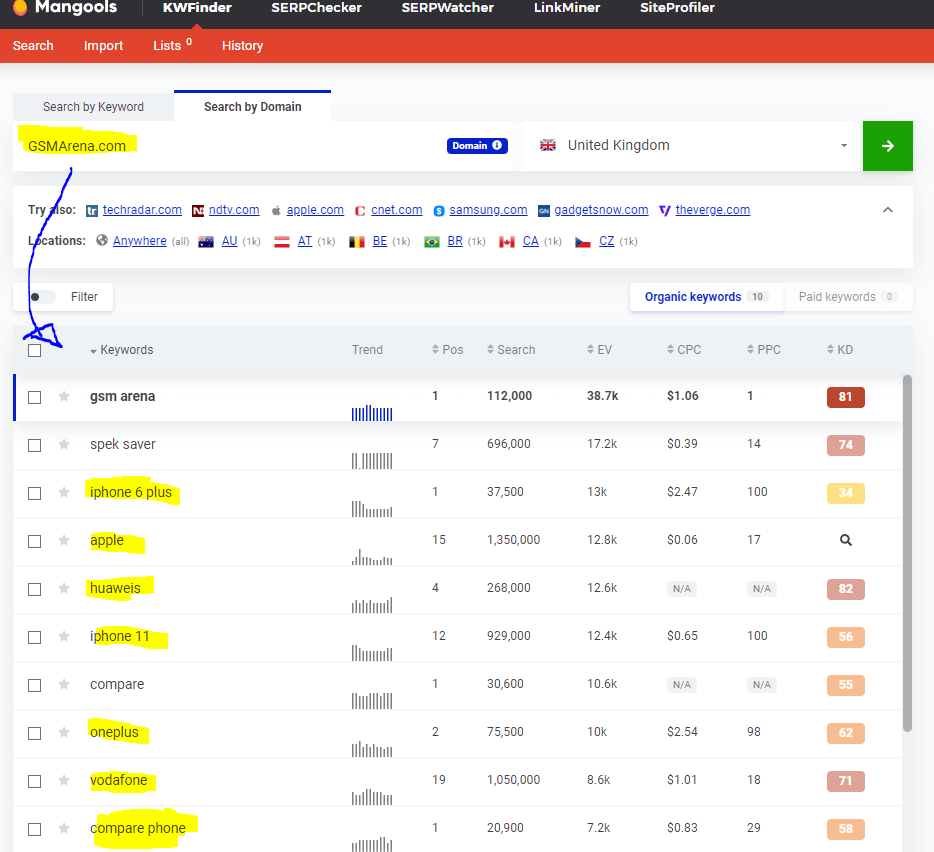
As you can see in the image above, The tool displays a detailed list of all keywords this website is ranking for. Which can give you many topic ideas to write about.
b- Spy On Your Competitor’s Keywords :
Let’s assume that you want to write an article about ‘ Top 5 best Smartphones in 2022 ‘ for your smartphone blog.
To find whose ranking for this topic, Just enter the keyword ‘ top 5 best smartphones in 2022 ‘ into Google and see who ranks for it.
Most of the time, you’re not gonna find your website in the results. But you will certainly find your competitor.
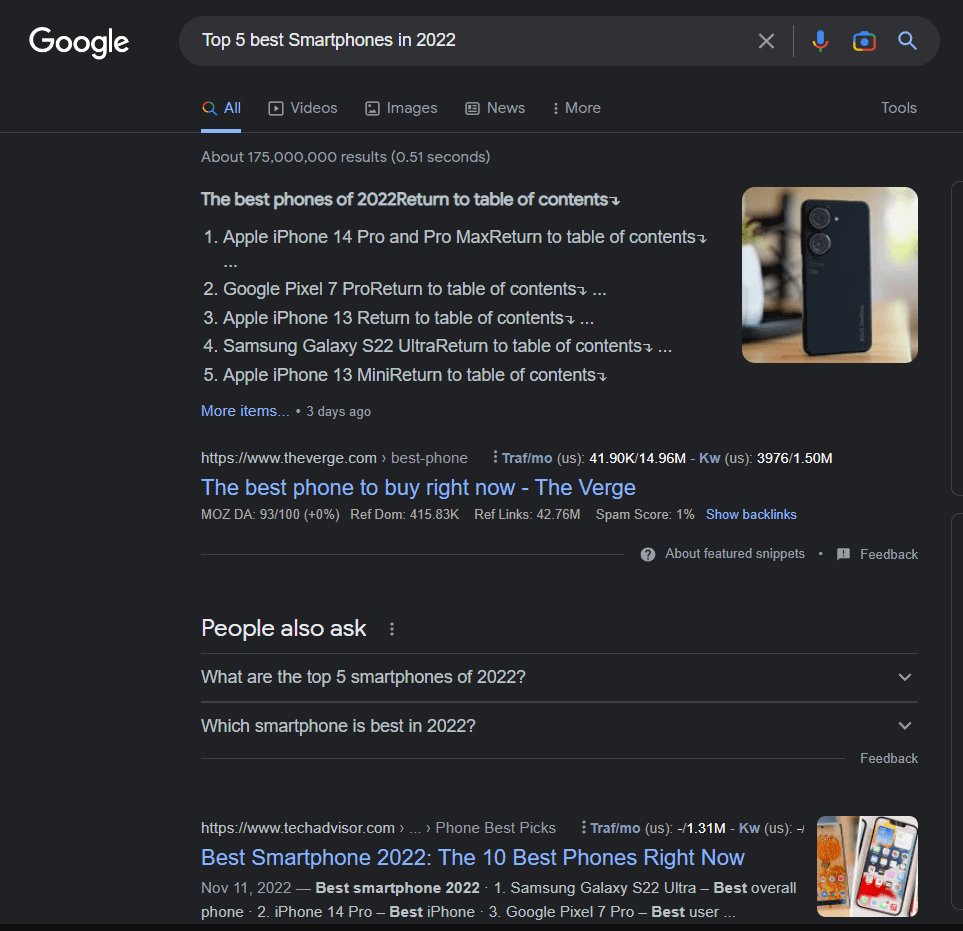
Once you find your competitor, enter the URL of his / her article in the ” search by domain ” section.
After clicking on ” find keywords”, The tool will start displaying to you all the other keywords that article is ranking for.
Therefore, you can use those keywords in your content to overcome your competitors. Surprising, Right?
Now, that we learned how to find keywords, let’s see:
How To Analyze Keywords ?
After choosing your list of keyword ideas, you need to select the ones that will bring the most traffic to your website.
Whenever you create a new piece of content, you need to give it a focus keyword. the focus keyword is a keyword that represents the main topic of the page and has the best potential to rank on Google. So, How to find the perfect keyword?
There are three main aspects that you need to take into your consideration while choosing keywords, which are :
1- The popularity
2- The Difficulty
3- The relevancy
Let’s start with :
1- The popularity of the keyword :
The popularity of the keyword usually means ‘ the search volume ‘ and it refers to how many people search for a certain keyword every month .
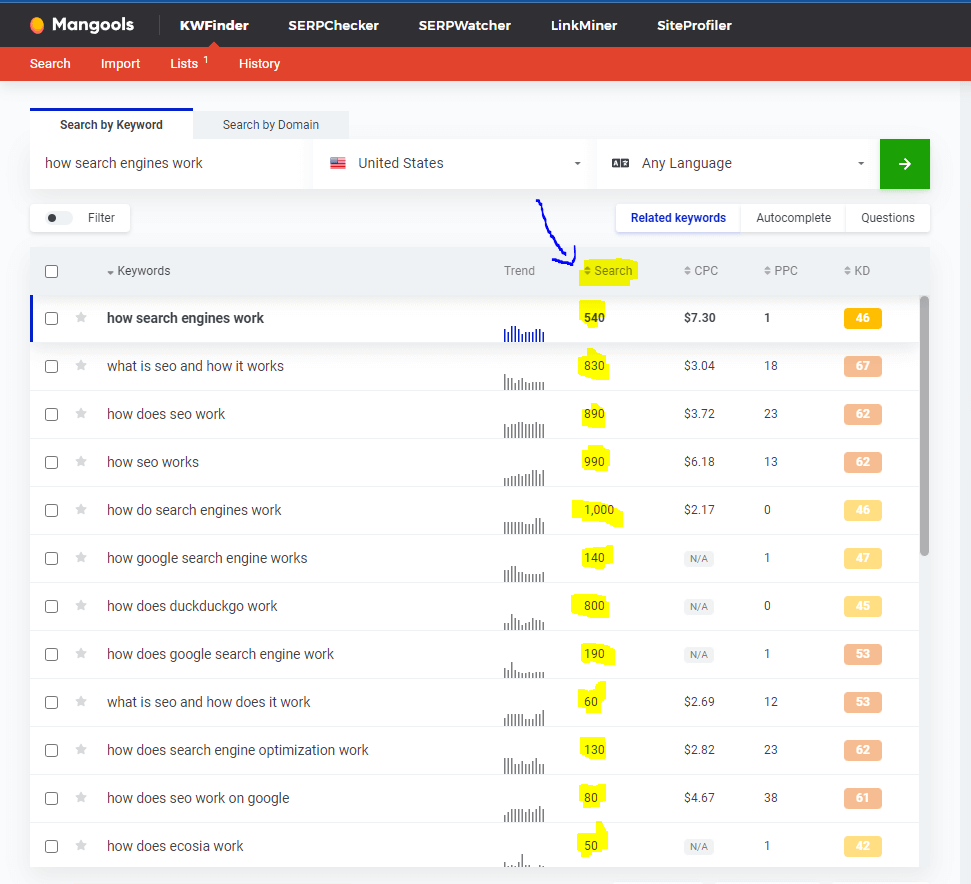
As a new website with no authority, you should always look after keywords that have high search volume and low competition.
And once you establish yourself in your field, you can start using big keywords that have high searches as well as medium/high competition.
2- The Keyword Difficulty:
The Keyword difficulty or “competition” is a metric used to determine how difficult it is to rank for a certain keyword. The higher the score is, the harder it is to rank for the keyword on your website.
It is based on the authority of page ranking for the given keyword.
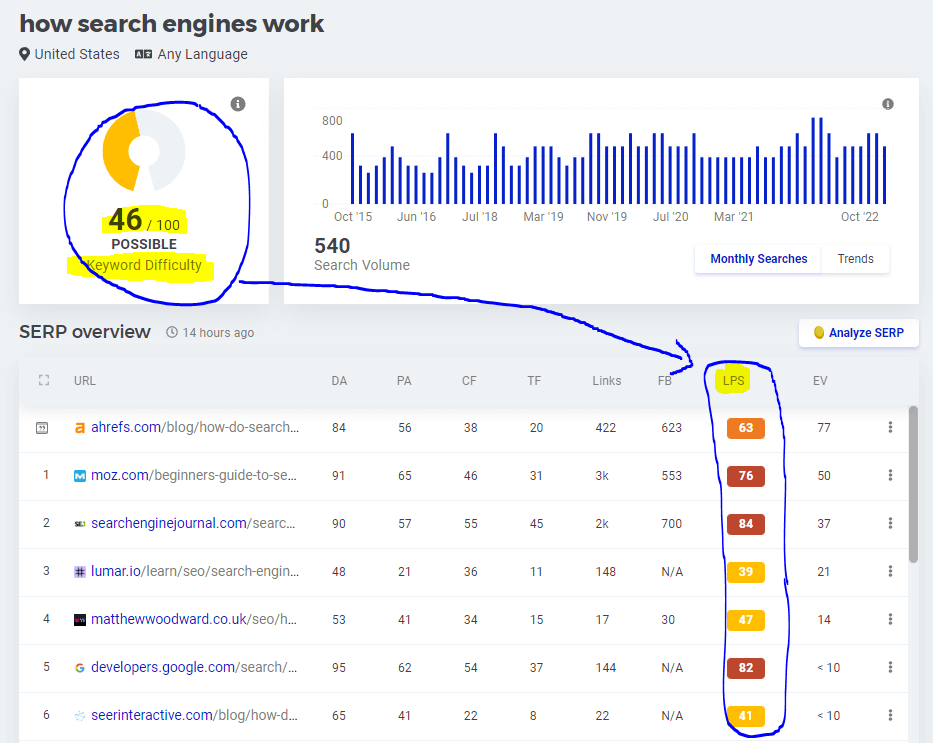
By keeping an eye on keyword difficulty, you’ll be able :
1- To identify keywords that you have the potential to rank for.
2- To focus on keywords that can bring you traffic even if you’re website has no authority yet.
3-To know your competitors.
3- The keywords relevancy:
Your keyword must be relevant and one of the easiest ways to discover if it is relevant or not is through a SERP analysis. But, Why?
1- To know if you can compete with websites in the 1st SERP or not.
2- To understand the search intent behind the keywords you want to optimize for.
By analyzing the intent of a search query, you can better understand how to optimize your content to match what the user is looking for.
There are four main search intent categories: informational, navigational, commercial, and transactional.
1- Informational intent searches are looking for information about a topic, such as “What is SEO?” ( They search for information ).
2- Navigational intent searches are used to find a specific website or page, such as “Google home page” ( They search for specific website or page ).
3- Commercial intent searches are looking to make a purchase, such as “ best laptop under $2000”( They want to do research before purchasing ).
4- Transactional intent searches are looking to take action, such as “buy a laptop online” ( They want to buy something online ).
By understanding the intent of search queries, you can create content that is tailored to the user’s needs and will rank higher in search results.
Let me give you an example:
Let’s say that you sell smart watches in your online store and you want to find a focus keyword for the product page of a new apple watch.
After your keyword research, You find the keyword “best apple watches”. It has a good search volume and it seems easy to rank for.
However, a quick look at the SERP will show you that your chosen keyword is not suitable for your content. But, Why?
Simply, because the search intent doesn’t match

As the image showed above, all the results are reviews and buying guides.
This means that Google understands that the keyword “best apple watches” is commercial.
And because your products page has a transactional character, it’s almost impossible to rank for that keyword.
Now, you have two options:
1- Find another keyword with a suitable intent ( Example: ‘ Apple Watches Buy ‘, ‘ Apple Watches Prices ‘ )
2- Create a new piece of content to match the search intent ( Example: a comparison between the best apple watches with links to your store )
The primary goal here is to match the query’s intent with your content type.
How To Use Keywords ?
Once you finish finding and analyzing keywords, you pick only one focus keyword that will represent your page.
The best practice is to use this exact keyword in:
- The title tag ( In the first four words of the title )
- The meta description
- The URL Or Permalink
- The heading of the page ( As well as in the sub-headings, If it’s possible )
- The Alt text
- Anchor text
Bear in mind that you should not stuff your keywords thinking you can fool the algorithm. Stuffing keywords is a black-hat SEO technique and it’s not working anymore.
That’s it. Now, you should be able to do keyword research on your own without any help from others.
If you’re looking for the best keyword research tools, check out this list: 5 Best keyword research tools in 2022
4- SEO Content or Content Optimization:
A lot of digital marketers think that Seo and Content are separate from each other, and the harsh truth is they’re wrong, but WHY? Let’s find out.
If your content is garbage, there’s no point in doing SEO. Because Search engines always prioritize Quality content over anything else.
Search engines seek the user’s satisfaction, and providing low-quality content to your users means upsetting them, which leads to a bad ranking eventually.
That’s the reason why Bill Gates ( Founder Of Microsoft ) said his famous quote: ‘ Content Is King ‘. Honestly, I can’t agree more.
Therefore, We decided to give you some practical tips on creating a successful content strategy in this SEO guide .
1- Focus Keyword Optimization:
Once you choose your seed keyword ( main keyword ), you should start using it to optimize your page for the given topic.
And here are some elements where you can place it:
1.1- Title tag :
The focus keyword must be included in the first Four words of the title.

1.2- Meta Description:
Same as in the title, the main keyword should be included in the meta description.

1.3- URL Or Permalink:
The seed keyword should be included in the URL as well. For example, if your focus keyword is: ‘ Gaming headsets ‘ , the URL can be something like” /5-best-gaming-headsets-in-2022/ “.
1.4- Heading and subheadings:
The Focus and side keywords should be included at least one time in titles from H1- H6
1.5- Image Metadata ( Alt text, Filename, Caption, Title ):
Alt text is the alternate textual content that defines images.
By writing the main keyword in the alt text, we give search engines an idea about the content of our images.
This way, we get more chances to appear in the image search results, which means more organic traffic to our website.
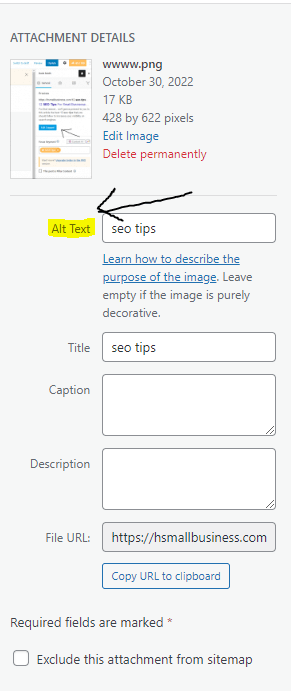
1.6- Body text:
The focus keyword must appear in the body text of the webpage at least one time .
1.7- Anchor text:
Anchor text is the visible, clickable text in a hyperlink.
On most websites, this text is usually dark or blue and underlined. Once you click on it, You get redirected to another page or blog post.

2- Quality Of Content:
Ranking for any keyword has become harder than how it was in the past. Because most niches are oversaturated. But, there is still one strategy that can overcome this issue.
This strategy is called The ‘ 10* Content ‘, So what is the’ 10* Content ‘ Strategy?
The ‘ 10* Content ‘ means creating content that is 10 times better than the highest-ranking results for a given topic or keyword(s).
How To Create A ‘ 10* Content ‘ Strategy?
1- Start by understanding your audience and what they are looking for. Research their needs, interests, and pain points to create content that is relevant and valuable to them.
2- Set specific, measurable, achievable, relevant, and time-bound (SMART) goals for your content. This will help you focus your efforts and measure the success of your strategy.
3- Develop a content calendar that outlines the topics, formats, and channels you will use to distribute your content. This will help you plan and organize your content creation efforts.
4- Create a variety of different types of content to engage your audience and keep them interested. This can include social media posts, videos, infographics, and blog posts…
5- Promote your content using a variety of channels, including social media, email marketing, and search engine optimization (SEO). This will help you reach a wider audience and drive even more traffic to your website/Blog.
6- Measure and analyze the performance of your content to see what is working and what is not. This will help you improve and refine your content strategy over time.
3- Content-Length:
In SEO, Content-Length refers to the amount of text on a page. Search engines always prioritize longer content over short ones.
Because longer content provides more comprehensive and in-depth information. Which makes it even more appealing to users.
However, having a lot of text on a page does not necessarily mean higher rankings. Because if this is the case, anyone can write garbage content and rank.
The content should be high quality, relevant, and easy to read to engage users and keep them on the Page/Website.
To wrap up, A high number of words doesn’t necessarily mean higher rankings. You need to improve the quality of your content if you want to make an impact on your SERP Position.
4- Content Updates:
In SEO, Content updates refer to the process of regularly adding new and fresh content to a website. This can include: blog posts, new product pages, or updates to existing pages.
Even if you have a lot of successful pages on your website, there’s always a bigger chance that the traffic will decrease over time unless you keep it fresh and up-to-date.
Instead of writing new articles or product pages, we look for pages that are already on our website to update, expand and optimize them to get back to their previous best ( or beyond ).
Pro Tip: not every topic or page needs updates, but many do.
5- Topic Organization:
One of the best ways to organize your topics is the so-called ‘ CONTENT HUBS ‘ . So, What is a content hub and how it works?
A content hub is a central location on a website where users can access a wide range of content on a specific topic.
Overall, There are two types of content to achieve that:
1- Pillar content: a pillar page usually provides a general overview of a broad topic; targeting one focus keyword (Example: Marketing )
2- Cluster content: the supporting pages that focus on subtopics within the same theme in detail (Example: Types of marketing, Importance of marketing, digital marketing …)
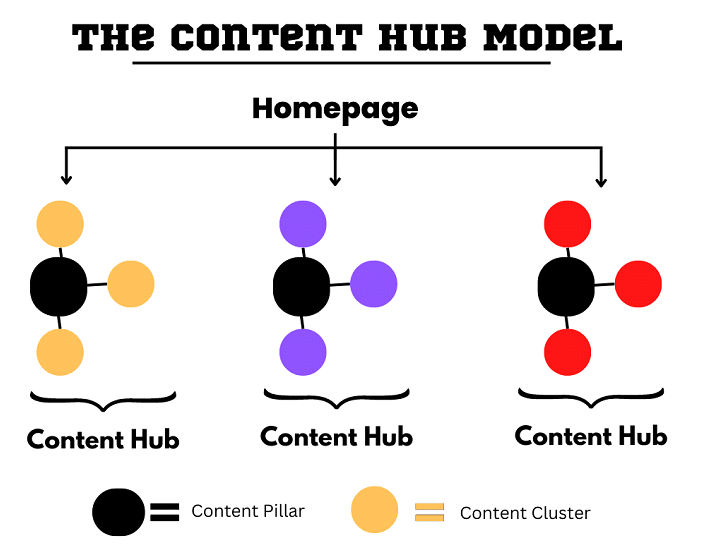
By Following this strategy:
You will increase your authority in certain topics by interlinking pages that are topically related to each other.
You Will Provide more value to your readers by covering every topic in detail so they don’t have to visit other websites/blogs to learn about them
5- On-Page And Technical SEO:
1- Internal Links:
Internal links are the links on your pages that drive traffic to other pages on the same website.
Internal Linking is one of the most important SEO practices, and here’s why:
1- It helps websites decrease the bounce rate to its minimum, which leads people to spend more time with your content instead of leaving it to other websites.
2- It helps search engine crawlers to find your website easily.
3- It helps improve your rankings on search engines.
And the Biggest advantage of internal linking is that you can control it as a site owner.
So, How To Build A Well-Interlinked Website?
It is so simple. Whenever you publish a new blog post, you link to the other posts on the website. But, the posts should be relevant to each other.
For example, If you want to write a blog post ‘ A ‘ about business, the other post ‘ B ‘ should be about similar topics like ‘ Marketing, Finance, Accounting … ‘.
Pro Tip: Do not link to other pages if they’re not relevant to each other.
2- Sitemaps:
A sitemap is a file that lists all the pages of a website and provides additional information about them ( Such as the last time they were updated…).
A well-structured sitemap can be very beneficial for SEO. Because, it allows search engines Like Google, and Bing to crawl and index the pages on your website easily.
So, How To Create A Sitemap For Your Website ?
To make it easy for you, Download The Rankmath Plugin to your website and connect it with the google search console.
Then, the plugin will submit the sitemap index file automatically to Google.
But, if you want to create your sitemap manually :
1- Open Your Google Search Console account
2- Click On ‘ Sitemaps ‘
3- Insert your sitemap URLs
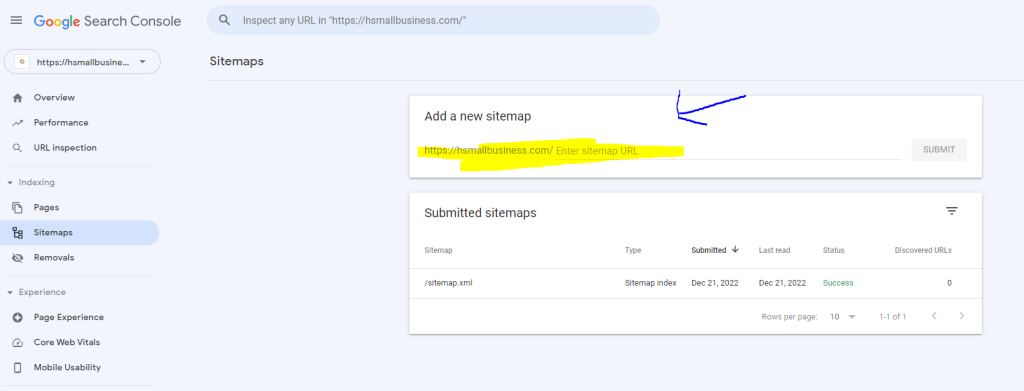
Then, Google will review your sitemap and accept it.
3- HTTPS:
In 2023, There is no excuse for you not to use the HTTPS protocol on your website. Not only because of the security of your website’s visitors.
But also because Google started to consider the HTTPS protocol as a minor ranking signal. This means that your website may perform worse if you don’t use it
4- Mobile Friendliness :
Mobile friendliness is an important factor in SEO. Because it affects how easily people can access and navigate through your website on their mobile devices.
In Practice, mobile friendliness means :
1- Having A Responsive Design ( which means that it automatically adjusts to the size of the device it is being viewed on)
2- Compressed Videos And Images
3- Readable fonts …
And to check if your website is mobile-friendly or not. Just Go To this tool from Google and paste your URL.
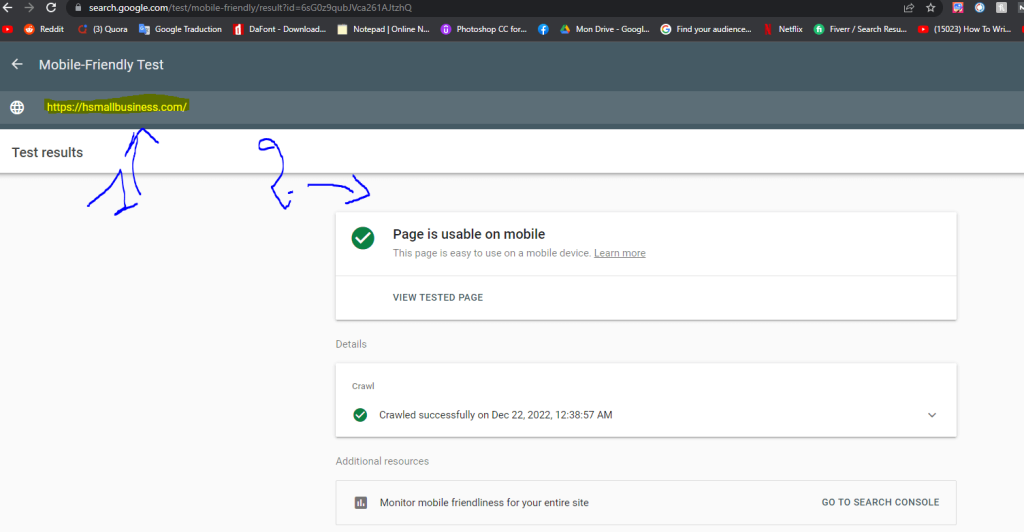
5- Title Tags And Meta Descriptions:
5-1: Title Tags:
The title tag is the name of the webpage and it should be powerful and unique to catch people’s attention and drive more traffic.
So, How To Write A Compelling Title For SEO?
To Write a compelling and attractive title, you must follow these three steps :
Step 1 – The focus keyword should be included in the title
EXAMPLE:
The focus keyword: gaming headsets
Title: 5 Best gaming headsets in 2022
Step 2- The focus keyword should be in the first four words of the title
Step 3- To increase the readability of the page, you should consider using a number and a power word in the title ( Like: Best – Big – Bright – Crazy … )
5-2: Meta Descriptions:
A Meta description is simply a brief conclusion or summary of your webpage content, and its maximum number of characters is: 160
And just like the Title, The meta description should also include the main keywords .
6- Featured Snippets:
A featured snippet is a summary answer to a user’s search query
displayed at the top of the search results page.
There are several types of featured snippets. But, the most common ones are :
1- The Definition box: this type of snippet is designed to give searchers direct and concise answers to their queries in a form of definitions and descriptions.
2- The Table snippets: consist of a table of information like comparison charts, prices, sizes, and dimensions…
3- Video snippets: these featured snippets consist of videos that are relevant to the user’s search queries.
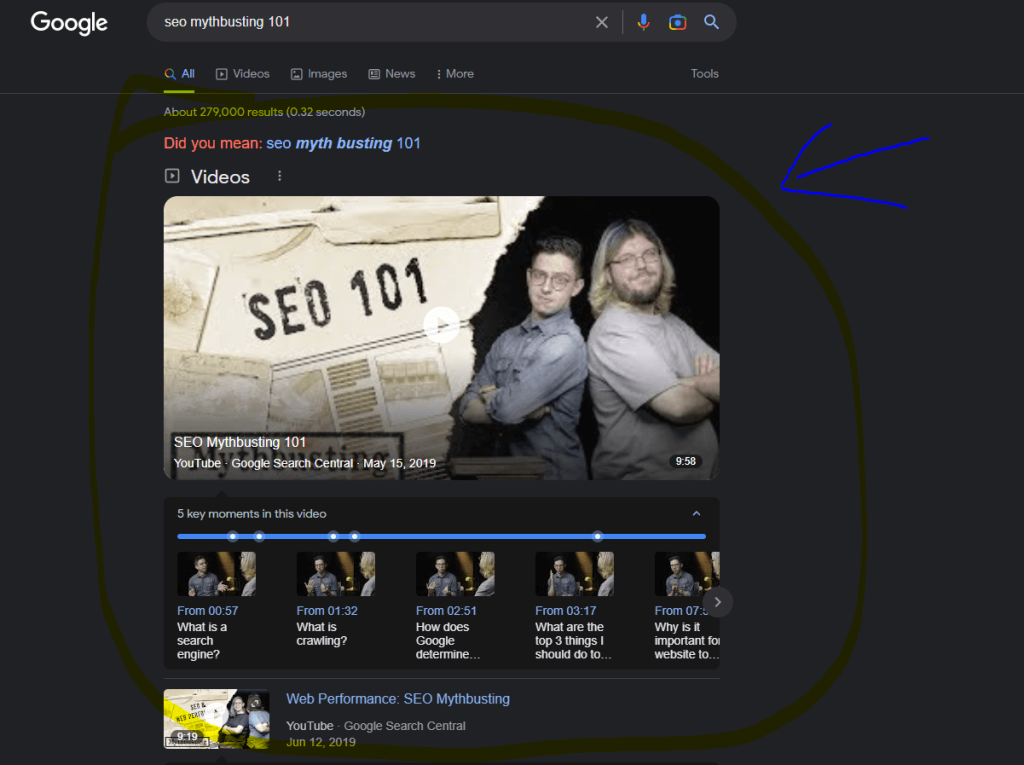
4- List Snippets: These featured snippets consist of a list of items, such as step by step lists or lists of ressources …
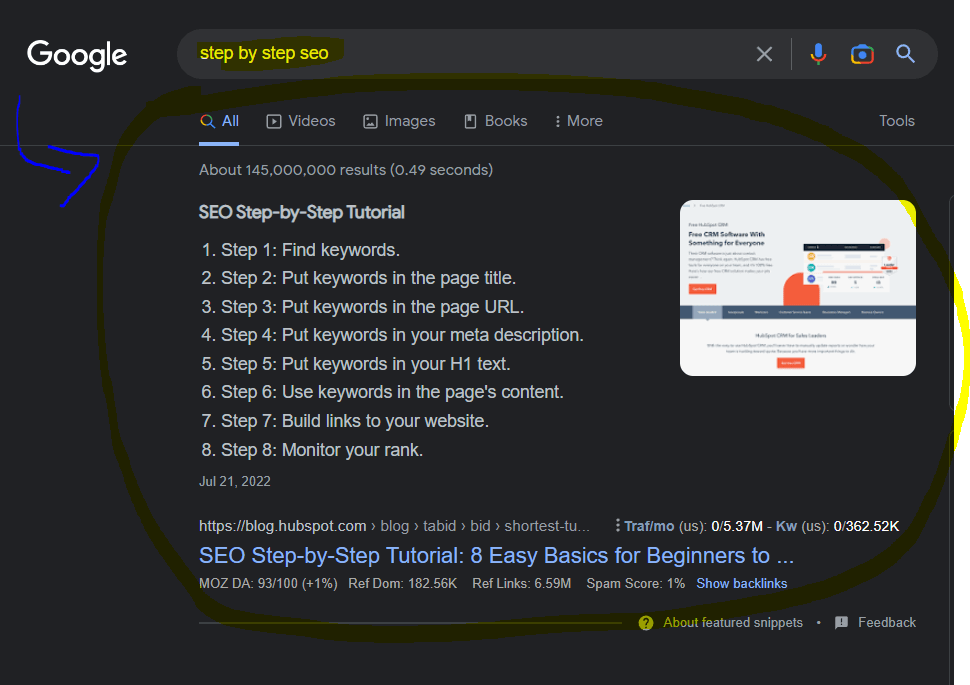
But the question here is ‘ Why Featured snippets are important in SEO ? ‘
Featured snippets are very crucial in SEO Because they can help you outrank your competitors even if your page has a lower position.
In addition, Appearing in the featured snippets box does not necessarily mean that your website should rank 1st for that specific topic or keyword.
So, How to get featured snippets?
Step #1: Search for keywords with featured snippets ( You can find these keywords by looking at the ‘ People also ask ‘ questions ).
Step #2: Answer those questions clearly and concisely.
Step #3: Follow the optimal word count ( The length of the assumed snippet text should be between 40-50 words ).
Pro tip: We do not mark what text, Video, or table should appear in the featured snippets box. Google and other search engines choose them automatically. All we need to do is optimize their length.
7- Page Speed :
Page speed is one of the most crucial aspects of technical SEO, and ignoring it will cost you a lot of traffic and visitors.
Because let’s be honest, no one is willing to wait even 1 minute for a website to load or for an image to appear.
That’s why it’s important to work on your website’s speed. But, How?
To measure and analyze your website’s speed, you can use:
1- Google PageSpeed Insights
2- GMetrix
3- Pingdom

7.1- Best Page Speed Practices:
1- Use Quality Hosting For Your Website ( Do not host your websites on weak, untrustworthy hosting providers because that can delay your website’s response time )
Pro Tips: These are the best hosting providers that you can use in 2023 :
1- Kinsta
2- SiteGround
3- Bluehost
2- Compress your images ( Image compression is the process of deleting unnecessary image data while preserving the same image quality )
Many websites can compress your images easily and for free, such as:
1- tinypng
2- iloveimg
3- compressjpeg
3- Limit Third-Party Scripts ( Using third-party scripts on your website like ‘WordPress Plugins ‘, ‘ ChatWidgets ‘ … can slow down the loading of your pages. That’s why it’s important to use only the needed services .)
4- Consider using the AMP ( AMP stands for ‘ Accelerated Mobile Pages ‘. AMP is designed to make web pages load faster and more efficiently on smartphones. Using AMP can help increase the page speed of your website on mobile devices and improve the user experience )
To download the official AMP Plugin on WordPress :
- Go to wordpress.org
- Search for AMP by ‘ AMP Project Contributors ‘ and hit download
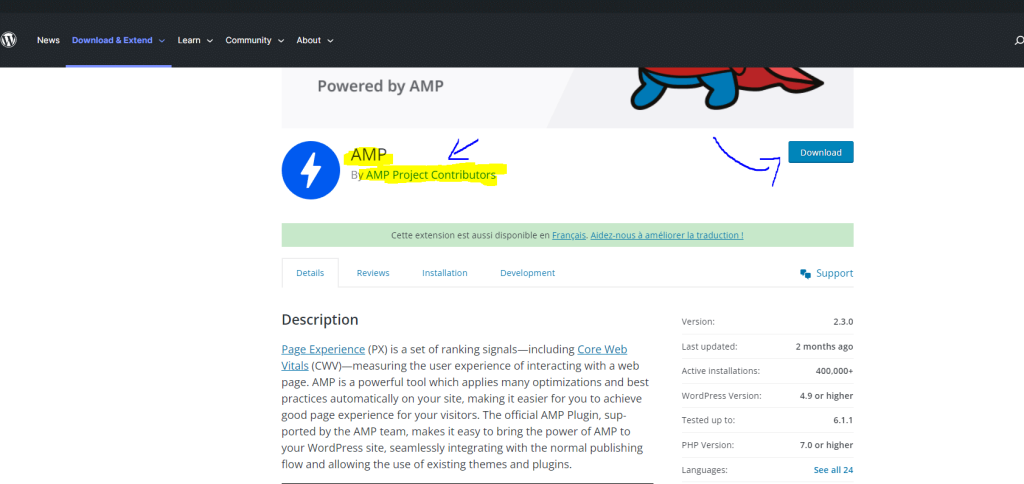
Then, install it on your website
5- Caching ( Cashing is the process of taking certain website resources like Images, Videos, HTML, and CSS and storing them in a temporary, easily retrievable format. So they can be quickly accessed by the users when requested )
There are three main types of caching in SEO, Which are:
5.1- Browser caching: When a user visits a website ‘ X ‘, their browser will store and save a copy of the web page and its elements in the cache, so it can be quickly accessed as soon as the user returns to the same website. You can use plugins like WProcket to do this job for you.
5.2- Server-side caching: When a user visits a website ‘ Y ‘, the server of this website will store all the pages and elements in its storage. So that it can be quickly accessed and served to the user when they return to the site instead of generating a whole new version whenever they come back.
This can help reduce the load on the server and increase the performance of the website.
5.3- Content delivery network (CDN) caching: ‘ content delivery network (CDN) is a network of servers in different geographic locations working together to get content to load faster by serving it from a location near the visitor ‘ Yoast Said.
When a user visits a website ‘ Z ‘, the CDN will try to serve the cached version of this website from the nearest server to reduce the load time and improve the user experience.
In general, these were the three main common caching types that can be used to improve the overall performance of a website.
6- Link Building:
1- What is a backlink?
Link building is the process of getting other websites to link back to your website to rank higher on the SERP and increase your site’s authority.
And because search engines always prefer quality over quantity, it’s very important to get a few trustworthy links rather than having dozens of inferior or spammy ones.
But, How Important Are These Backlinks ?
When Website X links to another website Y, that means Website Y Is good and worth mentioning.
Therefore, Search Engines will think the same and consider Website Y as a helpful site and will eventually rank it.
But, to convince search engines that your website is good, you need to get those backlinks from authority sites that have a lot of unique visitors every month.
2- Types of links:
There are many types and categories of links on search engines that you should know about, such as :
2.1- Internal And External Links ( What’s The Difference ? ):
An internal link is a link from one page to another within the same website. While an external link is a link from an external webpage.
2.2- Nofollow And Dofollow Links ( What’s The Difference ? ) :
A Dofollow link is a simple hyperlink that gives search engines the right and ability to track the traffic coming from it.
Note: By default, when you add an external link to your webpage, it will be in the DOFOLLOW setting.
A Nofollow link is a link that stops search engines from tracking its traffic, which means giving NO CREDIT FOR IT.
But, When to use Nofollow Links?
1- When you don’t want to endorse a specific website: Sometimes you need to link to some pages and websites that you don’t want to endorse. In these cases, you can use the ‘ Nofollow Link’.
2- When you don’t want to link to other small or low-quality websites.
3- When you use sponsored or promotional links ( So, you don’t violate Google’s rules )
What are the benefits of Nofollow links?
Nofollow links indeed pass no authority. But, they do bring some great benefits, such as:
1- Nofollow links help drive traffic: Even though Nofollow links are not counted from an SEO perspective. But, the traffic still counts.
2- Nofollow links help build brand awareness: when people click and visit your website, they automatically learn new things about your products and services.
3- Nofollow links can improve your domain’s authority.
4- Last but not least, it’s always good to have some Nofollow links on your website. Otherwise, Google will suspect you.
If you always use Dofollow links, Google may think that you’re using some kind of black-hat SEO techniques …
Plus, even big companies like YouTube, Amazon, and Facebook use Nofollow links on their website.
To wrap it up, Nofollow links make your link profile looks normal and natural.
What is A Link Profile?
In search engine optimization ( SEO ), A Link profile is a set of links that point to a website.
These links can come from a lot of sources, including Social media platforms ( Like Facebook, Twitter, Tiktok … ), Blogs and other publications, Forum discussions, and other websites …
A link profile is a crucial factor that search engines use to determine whether a website is worth ranking or not and having a strong link profile will help a website rank higher in comparison with other weak link profiles.
That’s why it’s important to provide high-quality content and get links from reputable and authoritative websites that can give your website’s link profile a strong boost.
What is the simplest way to build a strong link profile ?
There’s only one way to build a strong link profile and it is: QUALITY CONTENT.
The higher quality content you provide for your reader, the more links and anchor texts you’ll get.
What is an anchor text?
An Anchor text is the visible, clickable text in a hyperlink. It can be a word, phrase, or group of words.
Anchor texts help search engine crawlers determine the content and relevance of the linked page.
For instance, If a website ‘ X ‘ has an anchor text that reads ‘ best smartphones in 2023 ‘, that tells and indicates to search engines that the linked page ‘ Y ‘ is about Smartphones and electronics.
It’s always important to use descriptive and relevant anchor texts when referring to links because it helps search engines understand the content of the linked page as well as the linking page which can affect the ranking of both pages.
Types of anchor texts?
1- Exact match: this type of anchor text uses the same keyword that the linked page is optimized for.
For example: If the linked page is optimized for the keyword ‘ Bubbles ‘, the anchor text will be ‘ Bubbles ‘ ( Same difference ).
2- Partial match: this type of anchor text include all the keywords of the linked page but not as an exact phrase.
For Example: If the linked page is about ‘ SEO tools ‘, the anchor text might be ‘ Best SEO tools ‘ or ‘ Best Free And Paid SEO tools In 2023 ‘
3- Brand name: This type of anchor text use the name of brands as an anchor text.
For Example: if the name of the linked page is ‘ KWfinder ‘, the anchor text might be ‘ KWfinder ‘.
4- Generic: the anchor text is not specific and generic and does not include the target keyword of the linked page.
For example, the anchor text might be ‘ Read more ‘ or ‘ Click Here ‘ …
5- Images: This type uses images as anchor texts. When the image is clicked, it will take the users to the linked page.
6- Naked URL: Example: ‘ Https://hsmallbusiness.com ‘
What makes a good backlink?
1- Authority ( Aka: Link Equity Or Link Juicy ): A backlink from a high-quality website Like Shopify Or Mailchimp is more valuable than a backlink from a lower-quality website.
2- Relevance: Getting a backlink from a website that is topically relevant to yours is way more valuable than a backlink from a different niche website.
For Example, If you have a store selling ‘ Smartphones ‘ and you get two backlinks from different websites. The first one is from a blog that writes about ‘Sports’ and the second is from a website that talks about ‘ Electronics ‘. Which one do you think is more valuable from an SEO perspective?
Yep, you got it right. It’s the second one, Why? ‘ Topic Relevancy ‘
3-Anchor text: The anchor text of a backlink is the text that is used to link back to your website. A backlink with relevant anchor text like an ‘ Exact match ‘ or ‘ Partial match ‘ is more important than a ‘ generic ‘ one.
4- Uniqueness: Getting backlinks from new websites always drive more traffic and value. But, Does this mean getting backlinks from the same websites is harmful?
The answer is NO. But, acquiring links from new sources can boost the rankings of your website drastically.
5- Trustworthiness: This one explains itself. A backlink from a trustworthy website/blog is more valuable than an untrustworthy and spammy one.
Link Building Strategies:
1- Guest Posting:
Guest blogging is when you write a post for another website or blog as a guest in exchange for an external hyperlink to your blog.
Guest posting is one of the best and most effective ways to get backlinks and optimize your visibility on search engines.
Still, choosing guest posting opportunities carefully is essential to ensure that you get high-quality backlinks from reputable websites because search engines always prioritize the quality of backlinks over the quantity.
Take into your Consideration that these websites should have high authority and credibility to save your time and energy from wasting them on useless websites that give you nothing in return.
So, How do guest posting properly?
1- Go to Google And Search For the Following :
– ‘ Keyword ‘ + Write For Us
– ‘ Keyword ‘ + Contribute
Tips: Replace the ‘ keyword ‘ with the niche or topic of your Website.
EXAMPLES:
‘ Fashion ‘ + Write For Us
‘ Smartphones ‘ + Contribute
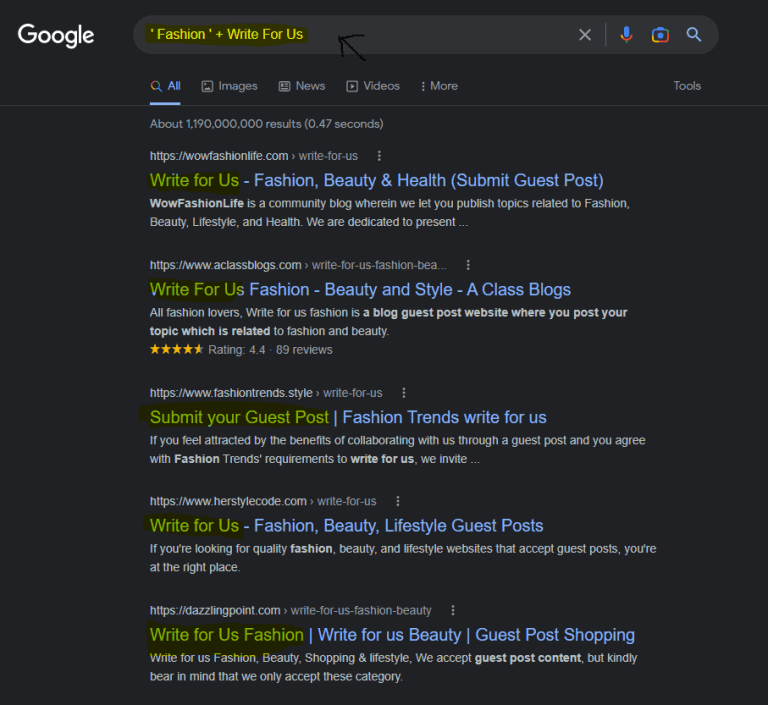
2- Make a list of websites that accept guest posting in your niche.
3- Contact the owners of those websites, introduce yourself, and pitch your guest post idea.
4- Once they like your post, they will accept your request.
Pro tip: Always Interact with blog commenters and stay in touch with the blog owners, building relationships is critical in this online world.
2- Social Media:
By posting high-quality content consistently on social media, you can get more people to see your content and potentially link to it in the future.
3- Influencers:
Influencers are people with a large following on social media or in their industry.
If you can collaborate with some of them to share your links on their profiles, it can be a powerful way to build backlinks.
But, these influencers should be in the same niche and industry as yours. For example, If you’re website is about ‘ Clothes ‘, the influencers you’re reaching out should be in the niche of ‘ Fashion ‘. Why?
Simply, Because their followers are more interested in fashion than other topics like ‘ Politics – Sport … ‘.
Therefore, they’d be willing to buy, watch, and read content that is related to fashion more than any other type of content.
How To choose the right influencers for your niche?
Firstly, make a list of twenty to thirteen influencers or bloggers that are related to your niche.
For that manner, You can use these free tools :
– BuzzSumo, which can help you find key influencers to promote your content.
– Foloowerwonk, which helps you find influencers On Twitter.
– Traackr is one of the best influencer marketing platforms you can rely on.
Secondly, start contacting and engaging with them on their social media pages or their blogs one by one, and ask them if They are interested in collaborating with you.
Thirdly, filter your previous list and keep only those who seem interested.
Lastly, Ask them for their permission to repost some of their articles or invite them to write a guest post or review your offerings.
If you want the easiest path, you can pay them to link to you in their articles or posts.
Pro Tip: Link building takes time and it’s not easy as it seems. Therefore, you need to be patient and over time you can see some great results.
4- Competitor’s Backlinks:
Using this strategy, you’ll be able to know all the websites that link to your competitors. So, you can contact them to link to you. How does this Strategy work?
1- Create a list of all of your competitor’s websites.
2- Use a backlink analysis tool like ( Linkminer )
3- Grab your competitor’s links and paste them into this tool
Once you click on ‘ search ‘, the tool will display to you all the websites that link to your competitors.
4- Contact these website owners and ask them if they can replace the backlinks of your competitors or add your backlink as an additional resource.
Pro Tip: As we explained earlier, your content should be High-Quality and better than your competitors.
7- Analytics And Metrics:
1- Google Search Console :
Google Search Console is a web service hosted by GOOGLE that allows marketers and webmasters ( People who manage websites ) to analyze and optimize their website’s performance on search engines.
1.2- How to use google search console?
Google search console ( GSC ) is divided into Seven sections and each one of these sections provides different information and tools related to your site’s presence on Google. Let’s start with the first one:
1- The Overview Section:
In the overview section, you can see and analyze your website’s performance on Google.
It includes information about how many clicks you get, the total amount of impressions, the number of indexed pages, Avg. the page view duration, and your top traffic channels …

Simply, it shows you a summary of your website’s performance.

2- The Performance Report:
The performance report helps you reveal more in-depth data and insights about your website’s performance on the SERP, including the total number of clicks, impressions, average click-through rate ( CTR ), average position, and the queries that drive traffic to your website.
Let’s begin with :
- The number of clicks: this one is pretty straightforward. It simply refers to how many people clicked on a link to your website in the search results.
- The number of Impressions: indicate how many people have viewed your website in the search results.
- The average click-through rate: refers to how many people viewed your link and clicked on it.
By tracking your website’s CTR (Click Through Rate ) , you’ll be able to identify your website’s least-performing pages and optimize them for SEO so they can appear in the SERP.
- The average position: Refers to your website’s position on the search results page. It measures how high your pages are ranking in the search results on average. The higher the number, the better.
Under each graph, you can check out your queries ( Best queries that you’re ranking for ), pages, countries, devices ( Mobile or Desktop ), search appearance
3- URL Inspection:
This tool allows you to check the indexing of every URL on your website.
For Example: If I want to check if this page ‘ https://hsmallbusiness.com/best-off-page-seo-techniques-in-2022/ ‘ is indexed.
I can Simply go to the ‘ URL inspection ‘ and paste the link, and the tool will show me if it is indexed or not.

4- Indexing ( Sitemaps ):
This section allows you to submit the sitemaps of your website for crawling, so they can be discovered and indexed by search engines.

5- Experience:
The experience section is divided into three sub-categories :
5.1- Core-web vital:
Core web vitals are a set of metrics that determine whether a website is well-optimized for SEO or not.
These metrics are loading speed, interactivity, and visual stability.
this tool will identify any issues on your website like slow loading pages, heavy images … so you can resolve them later .
5.2- Page experience :
The page experience is a set of factors that Google uses to assess the quality of the user experience on any website.
5.3- Mobile usability:
This tool detects all the problems that have been taking place in the mobile version of your website ( Like small text, buttons that don’t work properly … )
And for each page, you get one of these two statuses ‘ Error ‘ or ‘ Valid ‘. When you get the ‘ Error ‘ message, it means that you need to optimize that page to prevent it from getting lower rankings.
PRO TIP: The user experience should be smooth on your website’s mobile version as well as the desktop version.
6- Enhancement:
6.1- Breadcrumbs:
Breadcrumbs are a feature that allows you to see the hierarchy of your website’s pages.
EXAMPLE: ” Home > Blog > SEO Guide ” or ” Home > Store > clothing > T-shirt “
The breadcrumbs section shows you all the breadcrumbs that your website has.
Enabling breadcrumbs on your pages can improve the navigation and organization of your content as it will be easy for users to use your website.
6.2- Sitelinks search box:
First, let’s define the ” Sitelinks Search Box “
The Sitelinks search box is a feature that allows users to perform searches directly on websites from the search results.
Example:
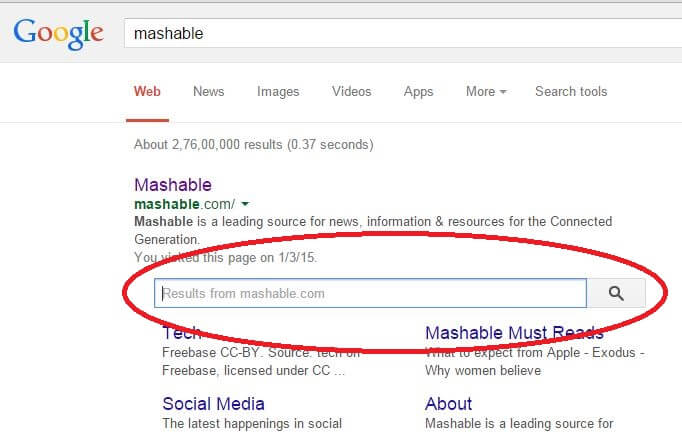
PRO TIP: Not all websites are eligible to have this feature.
In the Google search console, the Sitelinks Search Box gives insights on how this feature is being used on your website.
In addition to information about the queries that drive most traffic from the Sitelinks Search box, the number of clicks and impressions for each query…
7- Security and manual actions:
This section provides information on any security issues or problems that are affecting your website from the outside. In addition to any manual penalties that have been taken by Google.
8- Links:
This section provides information on the top linking websites and the top linked pages on your website.
2- Google Analytics:
Google Analytics is a free web analytics tool hosted by Google that allows webmasters to track and report on website traffic and user behavior.
It’s a very powerful tool to know who visits your website, Where they come from, what they do, what language they use …
1- How to Know Where most of your traffic comes from ( Google Analytics ):
To know the location of your traffic, you can simply open the ‘ Demographics ‘ tab and click on
” Demographic details “.
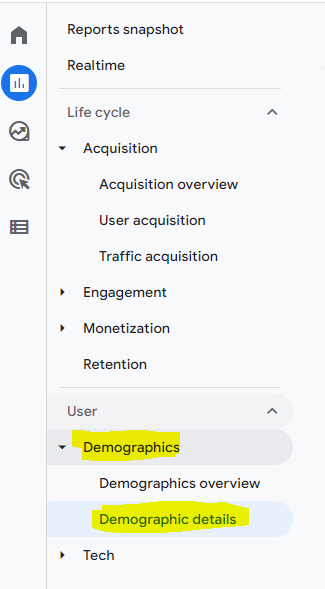
Then, you’ll be able to know exactly where your traffic comes from, the engagement rate, number of sessions per user …
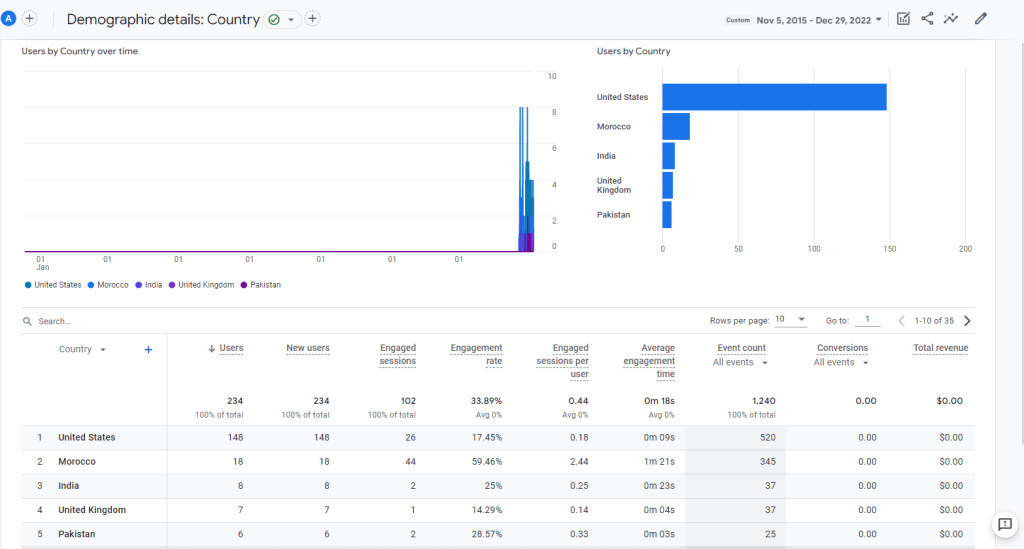
2- How to know the source of traffic of your website ( Google Analytics ):
Knowing the source of traffic of your website can help you concentrate your marketing efforts on channels that drive traffic. So, You don’t waste your time and energy on things that don’t make a difference.
To do that, open the ‘ Acquisition ‘ tab and click on ” Traffic Acquisition “. Then, the tool will display to you all sorts of channels that bring the most traffic to the website.
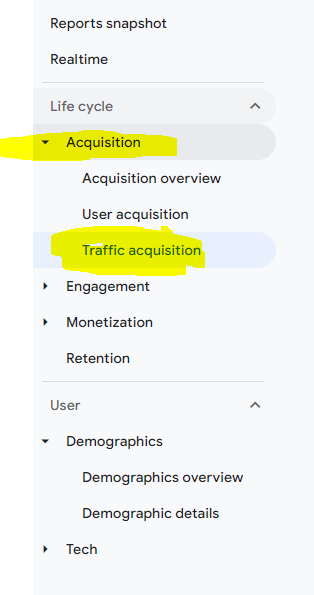
In addition to the number of users of each channel, views per user, User engagement duration per session …
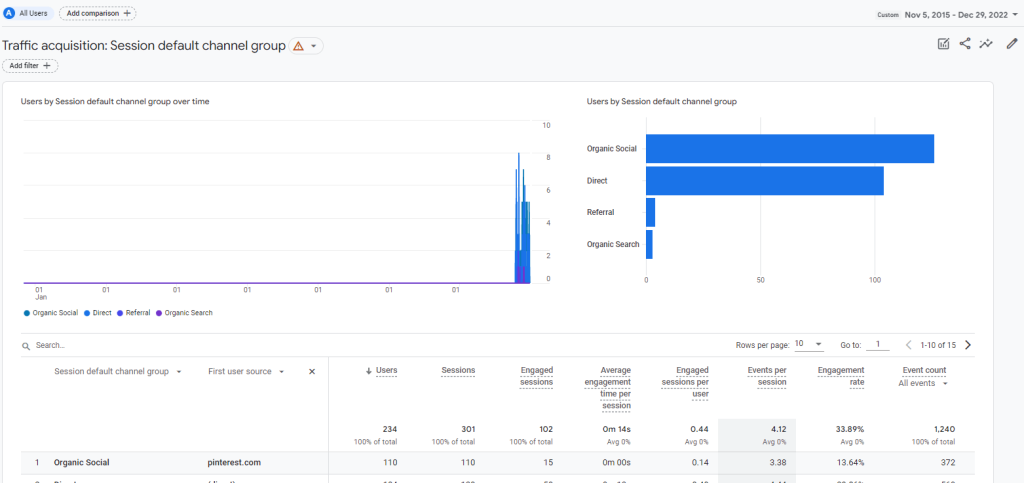
3- How to know what kind of pages your visitors see the most?
It’s really important to understand which pages drive the most visitors to your website to get an idea of what works and what does not.
So, for example: if there’s a page that doesn’t get that much attention, you will understand that you maybe should optimize it more for Seo, like changing the title, meta description, optimizing the content or the headlines …
To know what pages your visitors see the most, go to the ‘ engagement section ‘ and click on ” Pages and screens “.
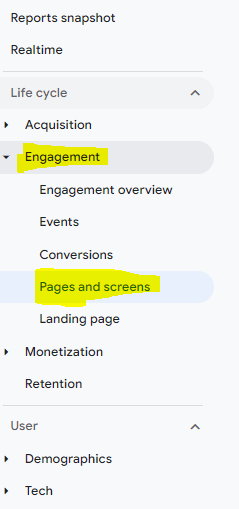
Then, the tool will display a graph pointing to the most visited pages on your website. Plus, a table that contains more additional information such as the number of users and clicks, the engagement rate …
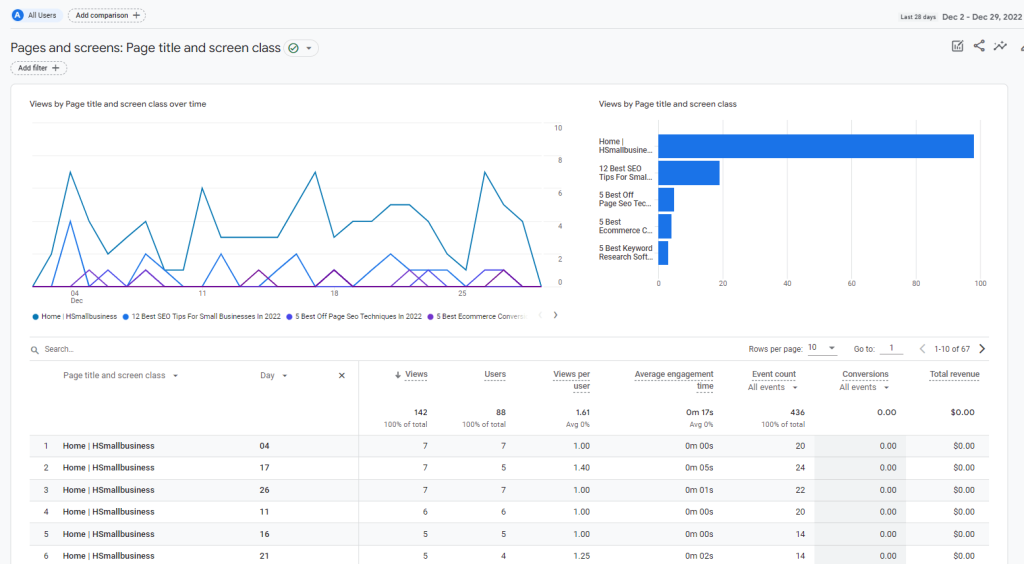
4- How to know the device categories, browsers, and operating systems of your traffic?
To get an idea about which device category your visitors use ( Mobile or Desktop ), and their browsers ( Google, Safari … ) … Go to the ‘ Tech ‘ section and click on ” Tech Details “.
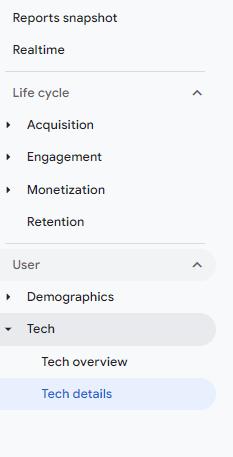

To get more in-depth information on how to use Google analytics, Check out this video:
3 Best Analytics Tips And Techniques To Measure The Performance Of Your Website:
1- Track Key Metrics: Identify the most important metrics to your business and track them regularly to have an overview of your data.
2- Set up event tracking: This way You will be able to understand how users are interacting with some specific areas on your website such as purchases, buttons, page views, and add to cart … to improve the user experience of your visitors.
3- Use Customer Feedback: Ask your visitors about their experience on your website to know which areas you can improve.
Conclusion:
To wrap up, SEO takes time.
You need to be patient and willing to spend long hours creating quality content, Optimizing it … But, Trust me It’s worth it when you start seeing results on your analytics dashboard.
Finally, If you have any more questions related to SEO, Please drop them in the comment section and I will answer them as soon as I can.
